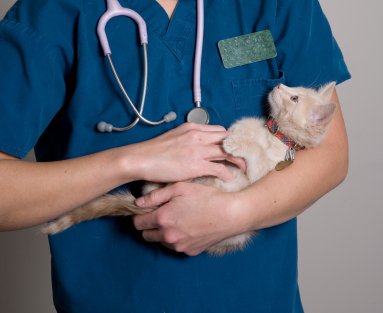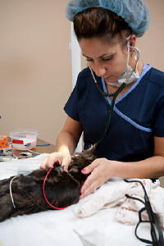Feline Hyperthyroidism

Feline hyperthyroidism ...just like in humans, older cats can suffer from thyroid problems and severe complications can result if the ailment is left untreated. Early signs of the condition are often too subtle for most owners to detect. A cat may exhibit a change in personality, become lethargic or more active, or show an increase in appetite.
Some
will even stop eating entirely if the disease has gone undetected for
some time. Frequently, there will be progressive weight loss, which may
be the only visible sign that something is wrong. The annual vet exam
should include a routine blood test so it can be detected earlier.
Generally, the cats are either losing weight and eating, or drinking more and not gaining weight. Some cats have an increased respiratory rate, some seem lethargic while others are more active. It can really present itself in numerous ways. While normal thyroid glands work by using iodine from a cat's diet to produce thyroid hormones, feline hyperthyroidism can result when a tumor on the thyroid gland causes an excessive amount of thyroid hormones to be produced. Almost always benign, these tumors are responsible for a number of symptoms, including increased appetite, weight loss and, if left untreated, heart failure and eventual death.
Most of the time feline hyperthyroidism results when the gland is too active. Sometimes it is seen with cancer. While some cats with benign thyroid tumors can survive months without treatment, neglecting the problem often results in other more serious ailments with the consequence being cardiac problems.
Pet owners who suspect their cats are suffering from a thyroid problem, that might be feline hyperthyroidism, should visit the vet for a checkup. routine blood tests and urinalysis can generally detect whether the thyroid gland is overactive, although more extensive testing may be required to zero in on whether it is feline hyperthyroidism. Your vet will conduct a thyroid scan to see if both glands are affected or if there are additional hyperthyroid nodules in the chest or other areas of the body.
The usual course of medication involves the administration of anti-thyroid medication such as Tapazole, a drug that blocks the production of thyroid hormones by the thyroid glands. The medication is given 2 or 3 times daily and does have some side effects. Vomiting, diarrhea or anorexia are the most common, more serious side effects such as anemia, low platelet counts, liver enzyme elevations, and low white blood cell counts can occur as well.
Treating with medication still leaves the tumor there and hormone levels will increase and the condition will return as soon as the medication is stopped, so owners must administer the medication daily for the rest of their pet's life. Giving daily pills for feline hyperthyroidism takes dedication and drug costs alone can run over $80 a month. For those who can't cope with the cost of daily drug doses, surgery is an option.
Surgery is often recommended when there is a tumor on only one of the lobes of the thyroid glands, or if the mass is cystic. If a veterinary center that specializes in nuclear medicine is nearby, your vet may recommend a thyroid scan prior to surgery. The scan can show the location of the abnormalities, which can occur not only in the thyroid lobes but in the neck and chest as well.
While surgery may cure the problem, at a cost of well over $1000, some cats may not be suited for the procedure. If both thyroid glands must be removed, hormone replacement therapy will likely be needed for a number of weeks to months. Complications can also result if the attached parathyroid glands, which regulate calcium levels, are damaged during the procedure. If that happens, calcium levels can fall perilously low, causing the cat to have muscle twitches or seizures and in extreme cases, death.
Because many cats suffering from feline hyperthyroidism are older, surgery often may not be the answer. The downfall of surgery is in putting an older cat under anesthesia. For cat owners who don't want to risk surgery or can't cope with the daily chore of medications, radioactive iodine therapy has become the preferred treatment.
The therapy is widely used in cats, with successful results. A battery of diagnostic tests, including blood-work, x-rays, urinalysis, thyroid scan, scintigraphy, and chemistry screens, are first conducted to help the veterinarian determine a patient's health and the extent of the treatment needed.
Cats with severe cardiovascular, renal, gastrointestinal, endocrine, hepatic or neurological disease, may be rejected for treatment or referred for other therapy. There are few veterinarians licensed to handle radioactive materials so you may be limited in the choice of facilities and your vet should be able to direct you to the nearest treatment center.
The therapy itself is simple. Since the thyroid gland uses iodine to produce thyroid hormones, the patient is injected intravenously with radiated iodine, which is picked up mainly by the abnormal thyroid cells. The radiation kills off the aberrant cells, effectively irradiating the tumor. For cats that exhibit feline hyperthyroidism in both thyroid gland lobes or have hyperthyroid tissue in the chest cavity, radio-iodine therapy is ideal. Also, since the treatment is non-invasive, side effects are minimized and it's usually a one-time treatment for 90% of cats.
Cats with large or malignant tumors may need a second round in 3-6 months and success is low with malignant tumors. This is an expensive (but successful in most cases) path to take so get an estimate prior to having any treatment done. A ballpark figure is $1500-2000 without counting the pre-treatment testing.
While no treatment is completely free of side effects, radio-iodine therapy offers both a cure and the least post-therapy problems. Most cats will show no side effects, though some may experience a temporary sore throat or a permanent change in the timber of their voice. In rare cases, acute thyroid toxicity can occur. Perhaps the biggest downside of radio-iodine therapy is the prolonged isolation period required to allow a cat's radiation levels to decline.
The isolation period for your cat after the procedure is mandated by the Nuclear Regulatory Commission so it has to remain 1-2 weeks before it can return home. During that time, owners are not allowed to visit or terminate the therapy.
When the radioactivity in the injected iodine reaches an acceptable level, your cat can return home with careful monitoring and you'll be required to maintain minimal contact with him for 2 additional weeks to avoid radiation exposure. After that, you and your cat can resume your normal lifestyle.
Related Articles......
Return from Feline Hyperthyroidism to Cat Health Homepage
Having trouble finding what you need? Cat Health Index & Site Map
OR
Do you have a question to ask?...Questions
OR
Do you have a cat story to share?...Simply click here to go to that page!
Copyright@2010-2020 All rights reserved.Cat-health-detective.com
This website is information only. Consult a veterinarian for medical assistance

"Like Us" on Facebook
or...
"Like Us" here




















